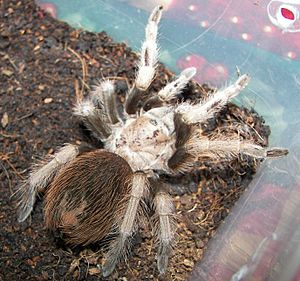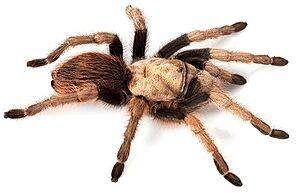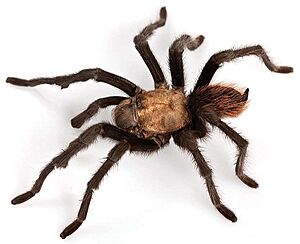Western desert tarantula facts for kids
Quick facts for kids Western desert tarantula |
|
|---|---|
 |
|
| Scientific classification | |
| Synonyms | |
|
The Aphonopelma chalcodes, also known as the western desert tarantula or Arizona blonde tarantula, is a type of spider. It belongs to the Theraphosidae family, which includes all tarantulas. You can find this spider in the deserts of Arizona and nearby parts of Mexico. Even though its home range is small, it's very common there.
The name "blonde tarantula" comes from the pale, light-colored hairs on its back, called the carapace. These light hairs stand out against its dark legs and body. These tarantulas are not very dangerous to humans. They also live a long time and can have many babies.
Contents
About the Western Desert Tarantula
This tarantula is a burrowing spider, meaning it digs homes in the ground. It can grow to be about 3 to 5 inches (8 to 13 cm) long. You often see them during the summer rainy season in the southwestern deserts.
Female tarantulas are usually a solid tan color. Male tarantulas have black legs, a copper-colored head-chest area, and a reddish belly. Females are usually bigger, up to 56 mm long, while males are about 44 mm long.
Their burrows can be 1 to 2 inches (25 to 51 mm) wide. They often put a few strands of silk across the entrance. This silk helps them know if prey is nearby.
How Tarantulas See
The A. chalcodes tarantula uses its eyes to survive. Spiders need good eyesight to find food and stay safe. These tarantulas have two sets of eyes: a primary set and a secondary set.
Their eyes are good at seeing different colors of light. They can see wavelengths between 350 and 640 nanometers. They see best around 500 nanometers and least well at 640 nanometers. Both sets of eyes see colors in a very similar way. The secondary eyes have a special part called a tapetum. This helps them see better in dim light. The way their eyes work is similar to how rods and cones work in human eyes.
Molting and Growth
Molting is when a spider sheds its old skin, called an exoskeleton. This process allows the spider to grow bigger. The A. chalcodes tarantula goes through about ten main molting stages. They can molt up to twenty-five times over two years. Each stage involves shedding a different part of their body, from their back to their legs. The first molting stage usually takes the longest time.
Tarantulas can molt at any time of day. However, molting often happens during certain seasons. For A. chalcodes, molting is most common in March and April. Scientists are still learning why they tend to molt during springtime.
Reproduction and Life Cycle
Young A. chalcodes spiders look like females when they are born. After several years, male spiders start to show their male traits. Male tarantulas grow special parts called palpal bulbs. They use these to store sperm and put it into the female's body.
Female tarantulas have pouches called spermatheca. They use these to store sperm until they are ready to lay eggs. When it's time to reproduce, females lay their eggs into the stored sperm. This helps the baby spiders get the nutrients they need. On average, a female lays about 600 eggs. The eggs hatch after about six to seven weeks.
Female A. chalcodes tarantulas can live for a very long time, usually 24 to 30 years. Males live much shorter lives, about 5 to 10 years. How long they live depends on where they live and how they grow. Females live longer because of differences in their bodies and how they reproduce.
Where They Live and How They Behave
The western desert tarantula lives in several states in the southwestern United States. They are very common in New Mexico and Arizona.
These spiders live in desert soil and can handle tough weather. They dig deep burrows to live in. These deep homes help them stay safe from big changes in temperature. But when the temperature is between 23˚C and 31˚C (73˚F and 88˚F), they often leave their burrows. A. chalcodes might dig under a rock or use burrows that other animals have left. They put silk strands around the entrance of their burrow. This silk helps them feel if prey is walking by while they are hiding inside.
This tarantula is mostly active at night. They start moving when the silk covering their burrow entrance breaks. This might happen because of their daily body clock, less light outside, or changes in the ground temperature. At night, they wait near the burrow entrance for prey. When morning comes, they go back deep into their burrow. Even though they are most active at night, you might sometimes see them near the top of their burrow during the day.
How Dangerous Is Their Venom?
Spider venom often contains special chemicals called neurotoxins. These chemicals can affect the nervous system. The venom of A. chalcodes contains two compounds called Apc600 and Apc728. These toxins are thought to help paralyze or stop the tarantula's prey for a short time.
The venom of A. chalcodes is not very dangerous to humans. A bite from this tarantula is often compared to a bee sting. In fact, these spiders are one of the least dangerous types in their tarantula family.
As Pets
Many people like to keep A. chalcodes as pets. They are popular with new tarantula owners because they live a long time. Males can live 5 to 10 years, and females can live up to 30 years. They are also known for being calm and gentle.
See also
 In Spanish: Tarántula rubia mexicana para niños
In Spanish: Tarántula rubia mexicana para niños



